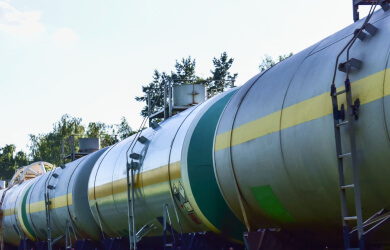The base oils market exhibits a dynamic nature, driven by a confluence of factors, including technological advancements, heightened environmental concerns, and shifts in industry preferences.
The worldwide base oil market is expected to see financial growth by 2027 while simultaneously experiencing a decline in volume, attributed to the further enhancement of product quality.
Challenges that confront the base oil market in 2023:
Fluctuating Crude Oil Prices: Base oils, being derived from crude oil, are inherently influenced by the volatile fluctuations in crude oil prices. Rapid and unpredictable changes in oil prices can disrupt the overall cost structure of base oil production, impacting market stability.
Competitive Landscape: The base oils market is marked by intense competition, characterized by the presence of several major players and numerous smaller manufacturers. This competitive environment can exert downward pressure on prices and necessitate continuous innovation to maintain market relevance.
Environmental Concerns: Heightened awareness of environmental issues has instigated a shift away from conventional base oils towards more sustainable and eco-friendly alternatives. This trend poses a challenge to traditional base oil producers, prompting them to adapt to evolving consumer preferences and stringent environmental regulations.
Trends in base oils and more
Not stable Demand: A significant trend has been the gradual reduction in demand for Group I base oils. This decline stems primarily from their comparatively lower quality and performance attributes when compared to more advanced base oil groups like Group II and Group III. As industry standards evolve, lubricant manufacturers are increasingly favoring higher-grade base oils.
Market Niche: Group I base oils have found a niche market in less demanding applications, particularly in the realms of industrial and agricultural lubricants. They continue to be employed in specialty formulations where their specific properties confer distinct advantages.
Blending and Recycling: Some companies have adopted strategies involving the blending of Group I base oils with other base oil groups or additives to enhance performance characteristics. Additionally, there has been growing interest in recycling and re-refining used Group I base oils as part of sustainability initiatives, reducing waste and enhancing environmental responsibility.
Focus on Sustainability: In response to mounting environmental concerns, the base oil industry has placed a heightened emphasis on sustainable practices. Companies are exploring innovative methods to minimize the environmental footprint of Group I base oil production, aligning with the evolving eco-consciousness of consumers.
Regulatory Compliance: Stringent environmental regulations and standards, particularly related to emissions and waste management, have exerted a substantial influence on the base oil industry. Compliance with these regulations has steered decisions concerning the use and production of Group I base oils.
Regional Variations: The adoption patterns of Group I base oils exhibit regional variations. In certain geographic areas, these base oils remain prevalent due to specific market conditions and regulatory requirements, further underscoring the nuanced dynamics of the global base oil market.
These trends and challenges collectively shape the evolving landscape of the base oil market, necessitating adaptability and strategic planning by industry participants to thrive in this ever-changing environment.

Group I: Group I base oils represent the traditional mineral-based oils that were widely utilized in the past. However, their market share has gradually declined due to the emergence of higher-quality base oil categories. In 2023, Group I base oils accounted for a diminishing portion of the overall base oil market, estimated at approximately 20-30%.
Group II: Group II base oils are characterized by greater refinement and enhanced performance compared to Group I. They have been steadily gaining market share and were estimated to constitute roughly 35-45% of the base oil market.
Group III: Group III base oils are subjected to even more extensive refining and are often classified as synthetic base oils due to their superior quality attributes. Their market share has been on the rise, particularly in applications where performance and environmental considerations are paramount. Group III base oils held an estimated market share of 25-35%.
Group IV (PAO – Polyalphaolefins): Group IV base oils, especially Polyalphaolefins (PAOs), are entirely synthetic and boast exceptional performance characteristics. They are commonly employed in high-performance lubricants and commanded an estimated market share of approximately 5-10%.
Group V (Esters, PAGs, and others): Group V base oils encompass a diverse range of specialty base oils, including esters and polyalkylene glycols (PAGs). Their market share can exhibit significant variability depending on specific applications and industries, but they generally constitute about 5-10% of the base oil market.
The growth of the Base Oil Market has been significantly influenced by rising demand across various applications worldwide:
Automotive Oil:
The expansion of the automotive industry has been a key catalyst for the Base Oil Market’s growth. As the global automotive fleet continues to expand, there is a growing demand for automotive lubricants, with base oils serving as a fundamental ingredient.
Industrial Oil:
The industrial sector relies on base oils to formulate lubricants that provide protection against wear, corrosion, and friction in various equipment, including turbines, compressors, and hydraulic systems.
Metalworking Fluids:
In industries such as aerospace, automotive, and machinery manufacturing, metalworking fluids play a pivotal role in metal cutting, forming, and machining operations. Base oils are a fundamental component of these fluids, providing essential lubrication and cooling properties.
Hydraulic Oil:
Hydraulic systems are integral to a wide array of applications, including construction, agriculture, and industrial machinery. Hydraulic fluids are indispensable for power transmission and the efficient operation of hydraulic equipment. Base oils are critical in hydraulic fluids, delivering necessary lubrication and thermal stability.
Process Oils:
Process oils find applications across diverse industries, including rubber, textile, and chemical manufacturing. They serve versatile functions, including plasticization, viscosity modification, and lubrication. Base oils form the foundational component of process oils, and their demand is shaped by growth and innovation within these industries.
Others:
Beyond the aforementioned applications, base oils are employed in various other sectors and specialty formulations, encompassing marine lubricants, gear oils, transformer oils, and more.
Key Market Drivers:
Automotive Industry Growth:
The automotive sector stands as a significant driving force behind the Base Oil Market. With the continuous increase in the global vehicle count, there is a parallel rise in the demand for automotive lubricants, consequently propelling the need for base oils.
Industrialization:
The process of industrialization, particularly in emerging economies, results in heightened machinery usage. This, in turn, spurs the demand for industrial lubricants and base oils to ensure optimal machinery performance.
Technological Advancements:
Ongoing research and development endeavors within the lubricants industry are leading to the creation of advanced lubricant formulations that necessitate high-quality base oils. This trend is fueling the demand for premium base oils.
Environmental Regulations:
The implementation of stringent environmental regulations is compelling the lubricants industry to craft environmentally responsible products. This has instigated a shift towards synthetic and bio-based base oils that have a reduced environmental impact.
These factors collectively shape the dynamic landscape of the Base Oil Market, underlining the importance of adaptability and strategic planning for industry stakeholders.
Price Fluctuations:
Similar to other commodities, the pricing of base oils adheres to the foundational principles of supply and demand. Production costs and global economic conditions also wield considerable influence. As a consequence of the ebb and flow of price trends throughout 2023, the year concluded with a 4% annual decrease in price statistics.
Legion Oil & Gas LLC in the Base Oils Market:
“After challenging year for base oils in 2023 we expect that prices will be stable to growing this year due to lower supplies available and recovering demand from the end users. Expected credit rate cut will have a positive impact on the global trade in general and on base oils and lubricants industry in particular, but it impact we may see in the second half of 2024″ – Denis Varaksin, managing director at Legion Oil & Gas LLC GmbH comments.
Legion Oil & Gas LLC increased volumes in Group II and III base oils. Additionally, the activity in re-refined base oils has seen growth, a development of significance in the context of the global commitment to curbing CO2 emissions.
The year 2023 marked a prosperous period for Legion Oil & Gas LLC, characterized by growth in multiple dimensions:
Suppliers: We welcomed two strategic suppliers into our network.
Events: Our participation in events, exhibitions, and conferences witnessed a 20% increase.
Human Resources: The company’s employee expanded by 15%.
Logistic Capacity: We added two strategically located warehouses to enhance our petcoke logistics.
Digitalization: The transition of offline processes to digital platforms commenced.
New Office: We moved into a new office in the heart of Berlin, in the center of Alexander Platz district.














